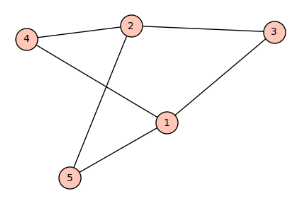5.2 KiB
5.2 KiB
- #MA284 - Discrete Mathematics
- Previous Topic: Advanced PIE, Derangements, & Counting Functions
- Next Topic: Definitions & Planar Graphs
- Relevant Slides:
-
Introduction to Graph Theory
- What is a graph? #card card-last-interval:: 4 card-repeats:: 2 card-ease-factor:: 2.7 card-next-schedule:: 2022-11-18T20:20:08.384Z card-last-reviewed:: 2022-11-14T20:20:08.384Z card-last-score:: 5
- What are adjacent vertices? #card
card-last-interval:: 4
card-repeats:: 2
card-ease-factor:: 2.7
card-next-schedule:: 2022-11-18T20:19:56.959Z
card-last-reviewed:: 2022-11-14T20:19:56.959Z
card-last-score:: 5
- If two vertices are connected by an edge, we say that they are adjacent.
-
Example
- Aoife, Brian, Conor, David, * Edel are students in an Indescrete Mathematics module.
- Aoife & Conor worked together on the assignment.
- Brian & David also worked together on their assignment.
- Edel helped everyone with their assignments.
- Represent this situation with a graph.
- Let the students be vertices
A,B,C,D,E. An edge represents collaboration between students. -
V = \{A,B,C,D,E\} -
E = \{\{A,C\}, \{B,D\}, \{E,A\}, \{E,B\}, \{E,C\}, \{E,D\}\} -
{{renderer :mermaid_fzjdzhfgs}} - ```mermaid flowchart RL A((A)) --- C((C)) B((B)) --- D((D)) E((E)) --- A E --- B E --- C E --- D ```
- Let the students be vertices
- Aoife, Brian, Conor, David, * Edel are students in an Indescrete Mathematics module.
-
Graph Theory - The Basics
- What is the order of a graph? #card
card-last-interval:: 4
card-repeats:: 2
card-ease-factor:: 2.7
card-next-schedule:: 2022-11-18T20:20:23.073Z
card-last-reviewed:: 2022-11-14T20:20:23.074Z
card-last-score:: 5
- The order of a graph
G = (V,E)is the size of its vertex set,|V|.
- The order of a graph
-
Equality & Isomorphism
- What makes two graphs equal? #card
card-last-interval:: 4
card-repeats:: 2
card-ease-factor:: 2.7
card-next-schedule:: 2022-11-18T20:20:18.088Z
card-last-reviewed:: 2022-11-14T20:20:18.088Z
card-last-score:: 5
- Two graphs are equal if they have exactly the same Edge & Vertex sets.
- That is, ^^it is not important how we draw them^^.
- Two graphs are equal if they have exactly the same Edge & Vertex sets.
- What is an Isomorphism? #card
card-last-interval:: 4
card-repeats:: 2
card-ease-factor:: 2.22
card-next-schedule:: 2022-11-18T20:17:59.530Z
card-last-reviewed:: 2022-11-14T20:17:59.530Z
card-last-score:: 3
- An isomorphism between two graphs,
G_1 = (V_1, E_1)&G_2 = (V_2, E_2), is a bijectionf: V_1 \rightarrow V_2between the vertices in the graph such that, if\{a, b\}is an edge inG_1, then\{f(a), f(b)\}is an edge inG_2 - Two graphs are isomorphic if there is an isomorphism between them.
- In that case, we write:
-
G_1 \cong G_2
-
- In that case, we write:
- An isomorphism between two graphs,
- What makes two graphs equal? #card
card-last-interval:: 4
card-repeats:: 2
card-ease-factor:: 2.7
card-next-schedule:: 2022-11-18T20:20:18.088Z
card-last-reviewed:: 2022-11-14T20:20:18.088Z
card-last-score:: 5
-
Example
- Show that the graphs
-
G_1 = \{V_1, E_1\}, \text{ where } V_1 = \{a,b,c\} \text{, and } E_1 = \{\{a,n\}, \{a,c\}, \{b,c\}\}; -
G_2 = \{V_2, E_2\}, \text{ where } V_2 = \{u,v,w\} \text{, and } E_2 = \{\{u,v\}, \{u,w\}, \{v,w\}\}; - **are not equal but are isomorphic. **
-
V_1 \neq V_2so graphs are not equal. -
{{renderer :mermaid_sewggjymkp}} - ```mermaid flowchart TB
subgraph G2 u((u)) --- v((v)) --- w((w)) end subgraph G1 a((a)) --- b((b)) --- c((c)) end ``` -
f: V_1 \rightarrow V_2given byf(a) = u,f(b) = v,f(c) = wis an isomorphism.- e.g.,
\{a,c\} \in E_1, and\{f(a), f(c)\} = \{u, w\} \in E_2.
- e.g.,
-
-
- Show that the graphs
- What is a simple graph? #card
card-last-interval:: 2.97
card-repeats:: 2
card-ease-factor:: 2.6
card-next-schedule:: 2022-11-17T19:16:42.421Z
card-last-reviewed:: 2022-11-14T20:16:42.421Z
card-last-score:: 5
- A simple graph is one that:
-
- has no loops (i.e., no edge from a vertex to itself).
- have no repeated edges (i.e., there is at most one edge between each pair of vertices).
-
- Because simple graphs are so common, usually when we say "graph" we mean "simple graph", unless otherwise stated.
- A simple graph is one that:
- What is a multigraph? #card
card-last-interval:: -1
card-repeats:: 1
card-ease-factor:: 2.5
card-next-schedule:: 2022-11-15T00:00:00.000Z
card-last-reviewed:: 2022-11-14T20:14:08.619Z
card-last-score:: 1
- A multigraph is a graph that does have repeated edges.
- In a multirgraph, the list of edges is not a set, as some elements are repeated. It is a multiset.
- A multigraph is a graph that does have repeated edges.
- What is the order of a graph? #card
card-last-interval:: 4
card-repeats:: 2
card-ease-factor:: 2.7
card-next-schedule:: 2022-11-18T20:20:23.073Z
card-last-reviewed:: 2022-11-14T20:20:23.074Z
card-last-score:: 5

